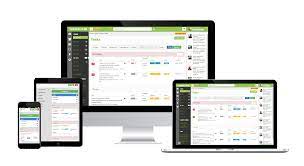Employee referrals are regarded as one of the most effective recruiting methods. Referred employees are the best employees in many ways, according to research: they take the shortest time to hire, they are less expensive to hire, they stay the longest with companies, and they have the lowest turnover rate. Learn what an employee referral program announcement is, what it benefits, some examples of a creative employee referral program poster, and how to create your own!
What is an Employee Referral Program?
An employee referral program is a recruiting strategy in which employers encourage current employees to refer qualified candidates for jobs in their organizations by offering incentives for doing so.
Employee Referral Program Examples
Employee referrals and employee referral programs are on the rise. And for good reason: referred new hires are often a better cultural fit, are more engaged, are less likely to leave, and are more productive. We’ll look at seven examples of employee referral programs in this section. There are many great examples of employee referral programs, and software tools for those programs.
#1. PURE
PURE, an American property insurance company, has a high referral rate: between 40% and 60% of its employees were found through referrals. Their secret? Don’t waste any time. As soon as a new hire has completed his or her first few weeks at the company, they are asked if they know of anyone else who might be a good fit for the firm.
This type of direct referral strategy has two main benefits: 1) it immediately leads to more referrals, and 2) it emphasizes the importance of referring.
#2. Salesforce’s happy hours
Salesforce, a US cloud computing giant, is well-known for the generous monetary and non-monetary rewards it provides to its employees. And not just for successful referrals, by the way; Salesforce staff has mindfulness rooms at its disposal, gets paid to volunteer in their community, and when they’ve gone 18 months without a promotion, they get help finding new challenges.
#3. InMobi’s bikes
When InMobi, a global mobile advertising and discovery platform, was in desperate need of engineering managers, its hiring team knew they had to come up with something extraordinary.
And so they did. They devised a country- and culture-specific incentive to motivate employees. In India, that meant a Royal Enfield (India’s Harley Davidson), and in the United States, it meant a Vespa.
Both vehicles were parked right at the office entrance to keep employees on top of their referral game. Employees at InMobi could choose between a brand-new bike and a trip to Bali for every successful referral.
#4. Fiverr’s gamification method
Fiverr, a freelance marketplace wanted to increase employee referrals by tracking social job sharing and adding gamification by awarding points for sharing jobs and referring friends.
As a result, Fiverr chose Zao, a company with an employee referral program (it has been acquired by PIXID). The software added a competitive element to referring candidates by awarding employees points and credit for all actions they took, not to mention, notifying them when the status of their referrals changed.
#5. Google’s razor-sharp questions
When it comes to examples of employee referral programs, this one exemplifies the power of simplicity beautifully. Recruiters at Google ask employees questions like, “Who is the best software developer you know in Boston?”
Asking such pointed questions forces people to think twice about the people they are referring to.
#6. Accenture’s emotional reward
Accenture, a Dutch consulting and IT firm, takes a different approach. The employee referral program at the company is based on the idea that referring people makes you feel good; either because you helped a friend find a job or because you helped the company find a brilliant new hire.
To maximize this feeling of ‘doing good,’ Accenture gave its employees the option to donate a portion of their referral bonus to a charity of their choice. To top it off, the company matched that amount.
#7. Intel’s double bonus
Intel has discovered a simple way to kill two birds with one stone. To stay on top of its diversity hiring, the American tech giant doubles its referral bonus when employees successfully refer women and minorities.
Read Also: 4 Ways to Encourage Team Spirit in the Workplace
Benefits of the Employee Referral Program
Because finding talent has been identified as one of the most difficult recruiting challenges, employee referrals are used as one of the primary sources for finding high-quality job candidates by the vast majority of modern recruiters. Companies that have not yet implemented a structured process have confirmed that this is one of their top priorities for the coming year.
In today’s world of data-driven recruiting, optimizing the most important HR metrics has become one of the top priorities for many companies that want to recruit and hire more productively. Here are some of the benefits of a creative Employee Referral Program:
#1. Improving hiring quality
As previously stated, referrals are regarded as an internal method of locating job candidates. This means that current employees are asked to refer a candidate for the open position. Your current employees are the best people to know who your candidate persona or ideal candidate is. This is why employee referrals are usually a much better fit than candidates obtained through other means.
#2. Lowering employee turnover and increasing retention
Referred employees frequently stay with companies the longest because they are a better fit from the start. Employees who better match organizational culture, norms, and values will also stay with the company longer. This has a significant impact on one of the most critical HR metrics: employee turnover rate.
#3. Lowering the time and cost per hire
Referred employees who learn about the company from current employees are frequently familiar with the hiring process and onboarding. Not only can you get their profiles and contact information quickly, but you can also hire and onboard them much faster.
#4. Improving employer brand
According to LinkedIn research, 75% of job seekers research the company’s brand and reputation before applying for an open position. When you ask your employees to recommend a candidate (and offer a good bonus), believe me when I say they will only say positive things about you and your Employee Value Proposition.
Because job seekers and candidates trust employees far more than employers or CEOs, this is an excellent method of attracting talent for future job openings. Building your talent pool with these people will not harm you; rather, it will make your hiring process much faster and more productive.
Read Also: What Is Outplacement and What Are Its Benefits?
Employee Referral Program Announcement
A referral program announcement email to employee template can be used to announce program details and ask employees to refer qualified candidates. Many companies agree that referrals are often their best hires. So, encouraging your employees to refer can significantly accelerate and improve your hiring process.
How do I send an employee an email announcement of the referral program?
Referred candidates are frequently the best hires. A well-structured Employee Referral Program can reduce hiring time, cost, and quality. Make changes to this referral program announcement email template to reflect the specifics of your referral program.
Don’t forget to include the following information in your employee announcement emails outlining the operation of your employee referral program:
- Why referrals are important to you
- How should employees refer candidates?
- What referral information do you require?
- How long does the process take?
- How does the bonus/reward program work?
Use this referral request email to request referrals from your employees, and include the following main points:
- Job description for the available position
- The most crucial requirements
- Principal roles and responsibilities
- The team and department they will collaborate with
Furthermore, explain your employee referral program policies and any employee referral bonus programs that you may have.
Template for referral program announcement email to an employee
Subject Line: Could you please assist us in finding an outstanding candidate for [Job Title]?
Hello everyone.
As you are all aware, we are constantly expanding. As a result, we are always in need of talented individuals like you! We wanted to include you in our recruiting process because we know you have some great people in your network.
We know that you, our current employees, know best who our ideal candidates are. As a result, we are confident that you, as recruiters, can take our Talent Acquisition strategy to the next level. Here are a few details I will include in every referral request to help you understand how the process will work:
- Why referrals are important to you
- How should employees refer candidates?
- What information about referrals do we require?
- How long does the process take?
- How does the bonus/reward program work?
I will ask you to refer your friends, but I also encourage you to visit our careers page regularly to check for any new job openings we may have. Please do not hesitate to contact us if you have any further questions about our Employee Referral Program.
Thank you in advance for your assistance!
[Your name]
Tips for Creating an Employee Referral Program
When developing your own employee referral programs, it is essential that you know how they typically operate. Let’s take a step back and look at a common employee referral process that most recruiters are probably familiar with.
The employee referral workflow
- A role becomes open.
- Based on job requirements and cultural fit, an ideal candidate is identified.
- The recruitment team issues a referral request for this specific job opening. Employees will notice the new opening on the internal job board if the program is more established.
- Employees search their networks for qualified candidates and approach them with information about the opportunity and company.
- If the candidate is interested, they send their resume to the employee contact, who forwards it to the recruiter and hiring manager. The candidate then bypasses the early stages of the hiring funnel.
- Once submitted, the recruiter enters the recommendation into their preferred employee referral program, and the employee receives credit.
- The recruiter and hiring manager screen the referred candidate in the usual manner, usually beginning with a phone or in-person interview.
- If the candidate is successful, an employee referral bonus or reward is given to the candidate.
This is a simple example of how a healthy employee referral system might work. This process can be repeated for all relevant job openings.
Do employee referral programs really work?
Yes. Referrals have been shown to cut hiring time by nearly half when compared to candidates who come from a company’s careers site.
What is a typical employee referral bonus?
The cash value of referral bonuses ranges from about $250 for entry-level positions to $25,000 for executive positions. The typical employee referral bonus ranges from $1,000 to $5,000.
What is the purpose of the referral program?
An employee referral program is a recruiting strategy in which employers encourage current employees to refer qualified candidates for jobs in their organizations by offering incentives.
What is the objective of the referral program?
The goal of a referral program is to bring in new leads for your company. But you’re not just inviting anyone in.
How do I run a successful employee referral program?
How to improve the effectiveness of your employee referral program:
- Describe the job requirements.
- Keep employees updated.
- Thank those who have referred you.
- Provide both monetary and non-monetary incentives.
- Experiment with referral strategies.
What are the 4 steps in the referral process?
The stages of the pre-referral process, and what do they entail?
- The initial concern about a student’s progress.
- Information gathering
- Information sharing and team discussions.
- Discussion of potential strategies.
- Strategy implementation and monitoring.
What are the four key elements of making a referral?
A Good Referral’s Components
- Connection.
- Authenticity.
- Consent.
- Follow-Up.
Conclusion
An employee referral program may be the quickest way to better hires. Your company will likely save on recruiting and onboarding costs, and meanwhile, you’ll have a strong pipeline of candidates at all times.
Related Articles
- EMPLOYEE REFERRAL: Definition and Bonus Programs
- 10 Tips for Marketing Your SaaS Business Online
- CANDIDATE RELATIONSHIP MANAGEMENT SYSTEMS: Guide To The Processes
- Funding Opportunity: GrayMatters Capital
- HOME DEPOT AFFILIATE PROGRAM: All You Need to Know and More






